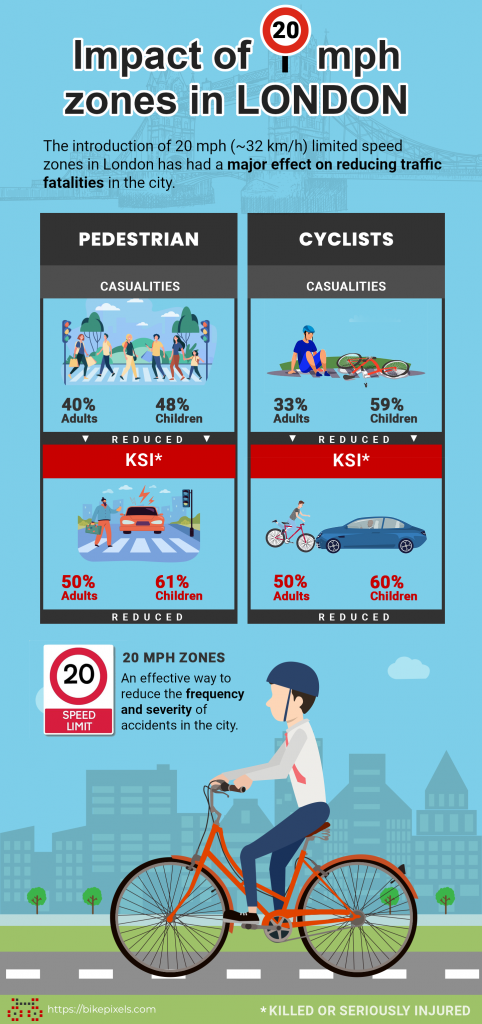Limiting speed on urban roads to decrease accident rates
11/01/2021The majority of the population now lives in urban areas. It is estimated that up to 75% of Europeans, 81% of Latin Americans and more than 82% of North Americans now live in cities. Although the number of accidents is not directly linked to the number of inhabitants of a city, the fact is that the majority of road accidents occur in urban environments.

In accidents occurring on urban roads, it is also more common for other road users to be involved in addition to the drivers and their passengers. The worst off, as always, are pedestrians and cyclists. To try to reduce these figures, one of the easiest and least expensive measures to be implemented by administrations is limiting the speed of motor vehicles within the urban area. By limiting its speed the safety of all road users is significantly improved.
A measure that works
This type of measure has been monitored for decades in different parts of the world. An analysis conducted in the UK in the late 1990s of road sections where speeds were reduced to 20 mph (about 32 km/h at the changeover) showed that the frequency of accidents was reduced by 56%. In addition, it was estimated that the average speed was reduced by about 9.3 mph (15 km/h). In other words, for each kilometer per hour of speed reduction, the number of accidents was reduced by almost 4%. The most significant reduction occurred in accidents involving children. Both pedestrian and cyclist accidents were reduced by 67%.
The same study was subsequently replicated in 2003 for the city of London by Transport for London, the body responsible for the British capital’s transport system. The results obtained were very similar and the most important figures are summarized in the following infographic.
In the case of London, reducing speed limits led to decrease in the number of accidents and the number of fatalities within the speed limit zones by 45%. This figure amounted to 57% in terms of the reduction of serious and fatal accidents. Furthermore, as shown in the infographic, the greatest reduction was achieved in the number of serious accidents among children.
For both pedestrians and cyclists the numbers of serious accidents among children were reduced by 61% and 60% respectively. During the study it was estimated that in areas where the speed limit had been introduced, serious injuries and fatalities of at least 66 people were avoided annually. In addition, the researchers estimated that this saved several million pounds in medical treatment and other external costs resulting from the accidents.

Spain as a testing ground
In Spain, from 11 May 2021, the speed limit on urban roads will be 20 km/h (~12 mph) on roads with a single carriageway, 30 km/h (19 mph) on roads with one lane in each direction and 50 km/h (~31 mph) on roads with two or more lanes in each direction. The main objective of limiting speed on such roads is to reduce the number of accidents. We should start to see a decrease in the number of accidents in the statistics over the next few years.
There are cities that have anticipated this measure. For example, since the end of 2018, Madrid City Council has imposed a generalised 30 km/h limit on all city streets with a single lane in each direction and a 20 km/h limit on single-platform streets. These make up 85% of the roads in the Spanish capital.
In this case, the statistics so far show no improvement in the number of accidents. In 2018 there were a total of 15,493 accidents in which 13,237 people were injured and 38 died. After the implementation of the measure, during 2019 there were 21,638 accidents in which 13,290 people were injured and 33 died. However, despite the increase in the number of accidents, the number of people injured and killed did not increase. You will find the complete series and the partial data for 2020 below:
However, this measure has led to a reduction in accidents involving cyclists. The following graph shows the number of accidents together with the number of serious injuries and fatalities.
As can be observed, after the speed limit, the upward trend in the number of accidents has been halted, due in part to the growing popularity of cycling as a means of transport among the people of Madrid. Despite this, the number of serious casualties and fatalities in accidents has been reduced. Both in 2019 and 2020, on average, the number of serious injuries and fatalities has been reduced by around 50% compared to previous years.
Conclusion
The conclusion is clear. By reducing speed limits on urban roads it is possible to decrease the number and severity of traffic accidents. With this solution, local authorities have an easy-to-implement tool to reduce pedestrian and cyclists injured and killed on our streets.
Like the use of helmets, this measure not only saves lives but also considerably reduces the total number of accidents and its severity. This also leads to a reduction of material and human costs.